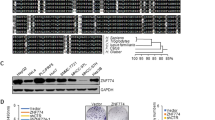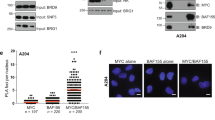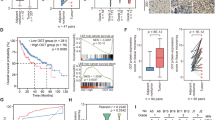Abstract
c-Myc N-terminal conserved domains, MbI and MbII, are essential for c-Myc-mediated transformation and transactivation. These domains recruit the STAGA (SPT3-TAF9-GCN5-acetyltransferase) coactivator complex, but not TFTC (TATA-binding protein-free TAF-containing) to the target gene promoter. Although components of this complex are well conserved between yeast and mammals, four mammalian orthologs of yeast SPT8, SPT20, SGF11 and SGF29 remain to be identified. Here, we isolated a rat ortholog of yeast SGF29, a component of yeast SAGA (SPT-ADA-GCN5-acetyltransferase) complex. Both rat (r) SGF29 and c-myc mRNAs were overexpressed in five out of the eight tested rodent tumor cells. rSGF29 directly interacted with rADA3 and co-immunoprecipitated with two other TFTC/STAGA components, rGCN5 and rSPT3. rSGF29 was recruited to the c-Myc target gene promoters together with c-Myc, and it activated c-Myc target gene expressions. Downregulation of rSGF29 suppressed the expression of c-Myc target genes and inhibited anchorage-independent growth and tumorigenicity and lung metastasis of rat hepatoma K2 cells when injected into nude mice. These results show that rSGF29 is a novel component of TFTC/STAGA complexes and could be involved in the c-Myc-mediated malignant transformation.
This is a preview of subscription content, access via your institution
Access options
Subscribe to this journal
Receive 50 print issues and online access
$259.00 per year
only $5.18 per issue
Buy this article
- Purchase on Springer Link
- Instant access to full article PDF
Prices may be subject to local taxes which are calculated during checkout








Similar content being viewed by others
References
Brand M, Yamamoto K, Staub A, Tora L . (1999). Identification of TATA-binding protein-free TAFII-containing complex subunits suggests a role in nucleosome acetylation and signal transduction. J Biol Chem 274: 18285–18289.
Frank SR, Schroeder M, Fernandez P, Taubert S, Amati B . (2001). Binding of c-Myc to chromatin mediates mitogen-induced acetylation of histone H4 and gene activation. Genes Dev 15: 2069–2082.
Grant PA, Schieltz D, Pray-Grant MG, Steger DJ, Reese JC, Yates I et al. (1998). A subset of TAFIIs are integral components of the SAGA complex required for nucleosome acetylation and transcriptional stimulation. Cell 94: 45–53.
Hampsey M . (1998). Molecular genetics of the RNA polymerase II general transcriptional machinery. Microbiol Mol Biol Rev 62: 465–503.
Ikura T, Ogryzko VV, Grigoriev M, Groisman R, Wang J, Horikoshi M et al. (2000). Involvement of the TIP60 histone acetylase complex in DNA repair and apoptosis. Cell 102: 463–473.
Liu X, Tesfai J, Evrard YA, Dent SYR, Martinez E . (2003). c-Myc transformation domain recruits the human STAGA complex and requires TRRAP and GCN5 acetylase activity for transcription activation. J Biol Chem 278: 20405–20412.
Luscher B, Larsson LG . (1999). The basic region/helix–loop–helix/leucine zipper domain of Myc proto-oncoproteins: function and regulation. Oncogene 18: 2955–2966.
Mammalian Gene Collection Program Team (2002). Generation and initial analysis of more than 15 000 full-length human and mouse cDNA sequences. Proc Natl Acad Sci USA 99: 16899–16903.
Marcu KB, Bossone SA, Patel AJ . (1992). myc function and regulation. Annu Rev Biochem 61: 809–858.
Martinez E, Kundu TK, Fu J, Roeder RG . (1998). A human SPT3-TAFII31-GCN5-L acetylase complex distinct from transcription factor IID. J Biol Chem 273: 23781–23785.
McMahon SB, Van Buskirk HA, Dugan KA, Copeland TD, Cole MD . (1998). The novel ATM-related protein TRRAP is an essential cofactor for the c-Myc and E2F oncoproteins. Cell 94: 363–374.
McMahon SB, Wood MA, Cole MD . (2000). The essential cofactor TRRAP recruits the histone acetyltransferase hGCN5 to c-Myc. Mol Cell Biol 20: 556–562.
Nilsson JA, Keller UB, Baudino TA, Yang C, Norton S, Old JA et al. (2005). Targeting ornithine decarboxylase in Myc-induced lymphomagenesis prevents tumor formation. Cancer Cell 7: 433–444.
Ogryzko VV, Kotani T, Zhang X, Schiltz RL, Howard T, Yang X-J et al. (1998). Histone-like TAFs within the PCAF histone acetylase complex. Cell 94: 35–44.
Pelengaris S, Khan M, Evan GI . (2002). Suppression of Myc-induced apoptosis in beta cells exposes multiple oncogenic properties of Myc and triggers carcinogenic progression. Cell 109: 321–334.
Pena A, Reddy CD, Wu S, Hickok NJ, Reddy EP, Yumet G et al. (1993). Regulation of human ornithine decarboxylase expression by the c-Myc. Max protein complex. J Biol Chem 268: 27277–27285.
Rodriguez-Navarro S, Fischer T, Luo M-J, Antunez O, Brettschneider S, Lechner J et al. (2004). Sus1, a functional component of the SAGA histone acetylase complex and the nuclear pore-associated mRNA export machinery. Cell 116: 75–86.
Saleh A, Lang V, Cook R, Brandl CJ . (1997). Identification of native complexes containing the yeast coactivator/repressor proteins NGG1/ADA3 and ADA2. J Biol Chem 272: 5571–5578.
Saleh A, Schieltz D, Ting N, McMahon SB, Litchfield DW, Yates III JR et al. (1998). Tra1p is a component of the yeast Ada Spt transcriptional regulatory complexes. J Biol Chem 273: 26559–26565.
Sanders SL, Jennings J, Canutescu A, Link AJ, Weil PA . (2002). Proteomics of the eukaryotic transcription machinery: identification of proteins associated with components of yeast TFIID by multidimensional mass spectrometry. Mol Cell Biol 22: 4723–4738.
Sugiyama A, Miyagi Y, Komiya Y, Kurabe N, Kitanaka C, Kato N et al. (2003). Forced expression of antisense 14–3–3beta RNA suppresses tumor cell growth in vitro and in vivo. Carcinogenesis 24: 1549–1559.
Urano Y, Iiduka M, Sugiyama A, Akiyama H, Uzawa K, Matsumoto G et al. (2006). Involvement of the mouse Prp19 gene in neuronal/astroglial cell fate decisions. J Biol Chem 281: 7498–7514.
Wang L, Liu L, Berger SL . (1998). Critical residues for histone acetylation by Gcn5, functioning in Ada and SAGA complexes, are also required for transcriptional function in vivo. Genes Dev 12: 640–653.
Zhang XY, DeSalle LM, Patel JH, Capobianco AJ, Yu D, Thomas-Tikhonenko A et al. (2005). Metastasis-associated protein 1 (MTA1) is an essential downstream effector of the c-MYC oncoprotein. Proc Natl Acad Sci USA 102: 13968–13973.
Acknowledgements
We. are grateful to Hanum Yaakub and T Sato for their technical assistance. This work was partially supported by the ‘Academic Frontier’ project for Private Universities: matching fund subsidy from MEXT (Ministry of education, culture, sports, science and technology), 2006–2010 (to FT).
Author information
Authors and Affiliations
Corresponding author
Additional information
Supplementary Information accompanies the paper on the Oncogene website (http://www.nature.com/onc).
Supplementary information
Rights and permissions
About this article
Cite this article
Kurabe, N., Katagiri, K., Komiya, Y. et al. Deregulated expression of a novel component of TFTC/STAGA histone acetyltransferase complexes, rat SGF29, in hepatocellular carcinoma: possible implication for the oncogenic potential of c-Myc. Oncogene 26, 5626–5634 (2007). https://doi.org/10.1038/sj.onc.1210349
Received:
Revised:
Accepted:
Published:
Issue Date:
DOI: https://doi.org/10.1038/sj.onc.1210349
Keywords
This article is cited by
-
SGF29 nuclear condensates reinforce cellular aging
Cell Discovery (2023)
-
Y chromosome is moving out of sex determination shadow
Cell & Bioscience (2022)
-
The male-specific factor Sry harbors an oncogenic function
Oncogene (2014)
-
Tra1 has specific regulatory roles, rather than global functions, within the SAGA co-activator complex
The EMBO Journal (2011)
-
Sgf29 binds histone H3K4me2/3 and is required for SAGA complex recruitment and histone H3 acetylation
The EMBO Journal (2011)



